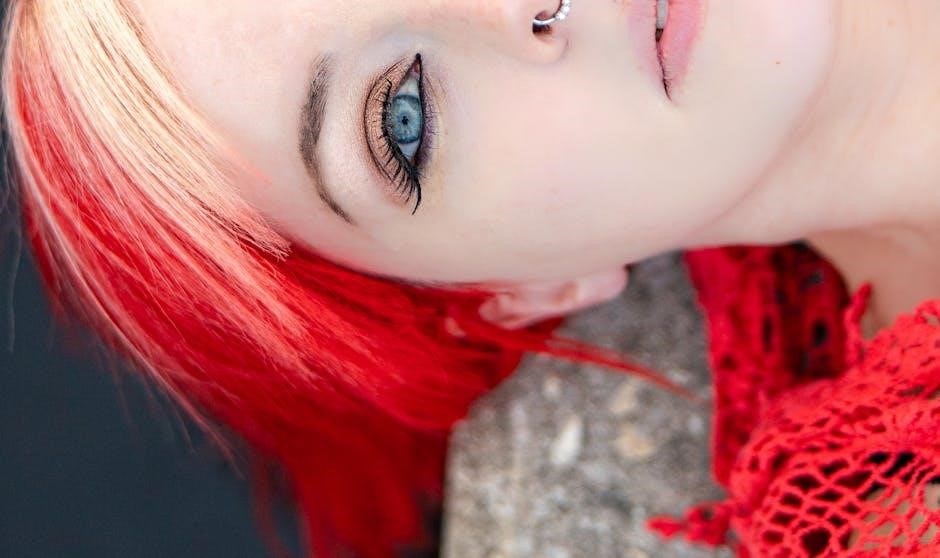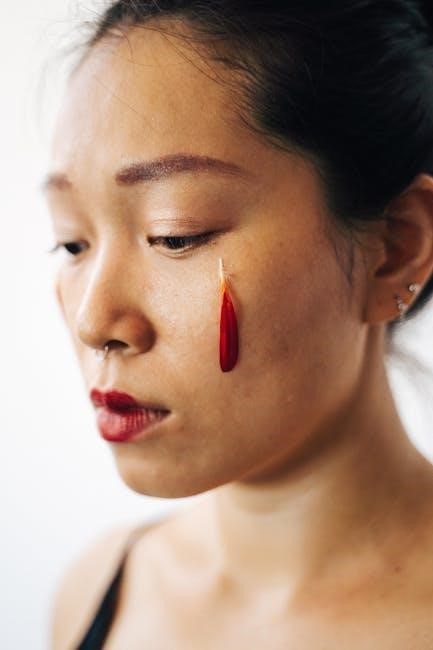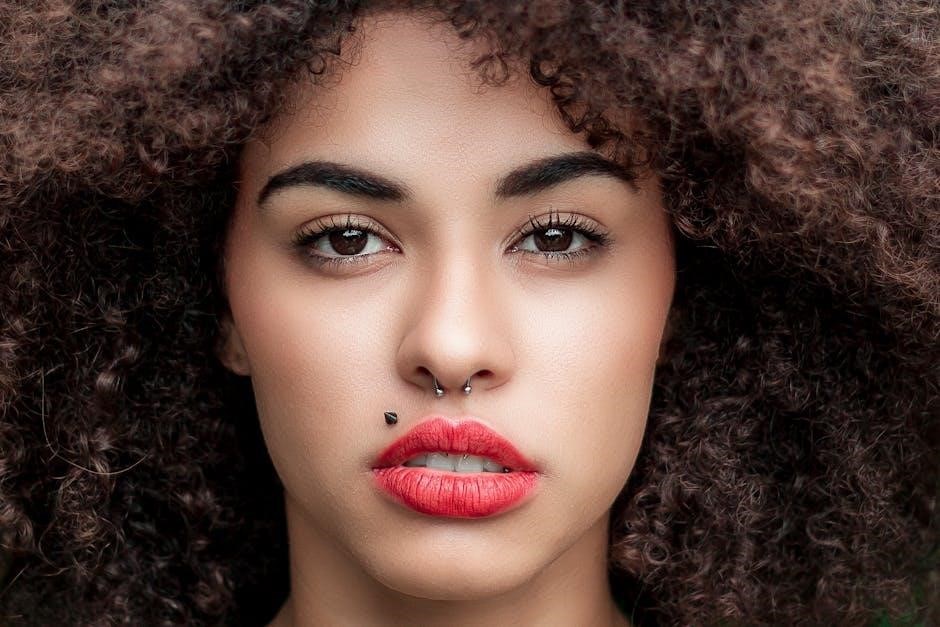lip piercing guide

Lip piercings are a popular form of body modification‚ offering a stylish way to express individuality. Whether it’s a labret‚ medusa‚ or snake bite‚ each type adds unique flair to one’s appearance‚ blending fashion and personal identity.
History and Popularity of Lip Piercings
Lip piercings have a rich history‚ dating back centuries to ancient cultures where they were used for spiritual‚ symbolic‚ and decorative purposes. In many indigenous tribes‚ lip piercings signified status‚ beauty‚ or spiritual connection. In the Western world‚ lip piercings gained popularity in the late 20th century as part of the body modification movement‚ becoming a symbol of self-expression and rebellion.
Today‚ lip piercings are a mainstream fashion trend‚ with various styles like labret‚ medusa‚ and snake bites gaining widespread appeal. Their popularity stems from their versatility‚ allowing individuals to showcase their unique style. Celebrities and influencers have further fueled their acceptance‚ making lip piercings a staple in modern aesthetics.
Why People Choose Lip Piercings
Individuals choose lip piercings for self-expression‚ personal style‚ and to showcase their unique identity. Many find it empowering‚ as it allows them to stand out and embrace their individuality. Others are drawn to the aesthetic appeal‚ with various piercing types offering versatility to match different looks and preferences.
Lip piercings also serve as a form of rebellion or a way to challenge societal norms. For some‚ it’s about confidence and feeling more authentic. The growing popularity of body modification has made lip piercings a trendy and socially accepted way to express oneself‚ attracting those who want to make a bold fashion statement while embracing their personal freedom.

Types of Lip Piercings
Lip piercings vary in style and placement‚ offering unique options for personal expression. Popular types include labret‚ medusa‚ and snake bite piercings‚ each with distinct characteristics and aesthetic appeal.
- Labret Piercing: Located on the lower lip‚ often adorned with studs.
- Medusa Piercing: Positioned on the upper lip‚ creating a striking visual effect.
- Snake Bite Piercing: Features two symmetrical piercings on the lower lip for a bold look.
These styles cater to diverse preferences‚ making lip piercings a versatile choice for body modification enthusiasts.
Labret Piercing: Definition and Placement
A labret piercing is a popular form of lip piercing that involves piercing the lower lip‚ typically in the center or slightly off-center. It is characterized by the use of a labret stud or ring‚ which adds a sleek‚ minimalist appearance. This piercing is often favored for its versatility‚ as it can complement various facial features and personal styles. The labret piercing is known for its subtle yet striking appeal and is a popular choice for those seeking a classic lip piercing look. Proper placement and jewelry selection are crucial for both aesthetics and comfort. With proper care‚ this piercing can heal well and become a timeless addition to one’s appearance. It is a favorite among both men and women due to its universal appeal and adaptability. Healing typically takes 6-8 weeks‚ making it a relatively low-maintenance option for piercing enthusiasts.
Medusa Piercing: Characteristics and Style
A Medusa piercing is a striking form of lip piercing located on the upper lip‚ typically centered directly below the septum of the nose. This piercing is characterized by its elegant and subtle appearance‚ often accentuated with a small stud or hoop. The Medusa piercing is named for its resemblance to the mythical figure Medusa‚ adding a touch of bold yet refined style. It is particularly popular for its ability to enhance facial symmetry and add a touch of sophistication. The jewelry of choice for a Medusa piercing is usually a delicate stud or a dainty hoop‚ which complements the natural curves of the lip. This piercing is ideal for those seeking a unique‚ eye-catching look that balances edginess with elegance. Its placement and style make it a standout choice in the world of lip piercings.
Snake Bite Piercing: Symmetry and Aesthetics
The snake bite piercing is a bold and striking option that features two symmetrical piercings on the lower lip‚ creating a look that resembles snake fangs. This piercing is highly prized for its aesthetic appeal‚ as the symmetry enhances the natural contours of the face. The dual piercings create a daring yet balanced look‚ making it a popular choice for those seeking a standout style. The jewelry typically used includes studs or hoops‚ which can be customized to suit individual preferences. While the piercing process can be uncomfortable‚ the result is a sleek‚ edgy appearance that adds a rebellious touch to one’s look. Proper aftercare is essential to ensure healing and maintain the piercing’s visual appeal. The snake bite piercing is a statement piece that combines symmetry with a unique‚ fashionable flair.

Horizontal Labret Piercing: Unique Placement
The horizontal labret piercing is a distinctive and modern variation of traditional lip piercings. Unlike the vertical labret‚ this piercing involves inserting jewelry horizontally across the lower lip‚ creating a unique and eye-catching look. The placement allows for a variety of jewelry styles‚ such as curved bars or studs‚ which can enhance the piercing’s aesthetic appeal. This type of piercing is ideal for individuals seeking a bold‚ yet subtle modification that stands out from more common lip piercings. The horizontal labret offers a fresh twist on traditional designs‚ making it a popular choice for those looking to express their individuality with a modern flair. Its uniqueness lies in its ability to complement facial features while adding a touch of edginess to one’s style.
Preparation for a Lip Piercing
Preparation involves researching reputable studios‚ understanding the piercing process‚ and ensuring proper hygiene. Arrive with clean skin and wear comfortable clothing for ease of access.
Research and Choosing a Reputable Studio
Researching and selecting a reputable studio is crucial for a safe and successful lip piercing experience. Look for studios certified by professional organizations‚ such as the Association of Professional Piercers (APP).
Check online reviews‚ ask for referrals‚ and visit studios in person to assess cleanliness and professionalism. Ensure the piercer uses sterilized equipment and follows proper hygiene protocols.
A reputable studio will have a clean environment‚ knowledgeable staff‚ and transparent policies. Avoid studios that cut corners or use low-quality jewelry. Taking the time to choose a trustworthy studio reduces risks and ensures a positive experience.
Understanding the Piercing Process
Understanding the piercing process is essential for a smooth experience. The process begins with a consultation to discuss placement and jewelry preferences.
The piercer will then mark the area with a precision tool to ensure accuracy. Once you’re ready‚ the piercing is done using a sterile needle‚ creating a small wound for the jewelry to be inserted. You may feel a brief pinch‚ but the process is quick. After the piercing‚ the piercer will provide aftercare instructions to promote healing. It’s important to stay calm and follow directions closely. While the process is straightforward‚ individual experiences may vary. Proper communication with your piercer ensures a positive outcome.
Aftercare and Maintenance
Proper aftercare is crucial for lip piercing healing. Keep the area clean‚ avoid irritants‚ and refrain from playing with jewelry. Avoid tight clothing and certain foods. Monitor healing progress regularly.
Best Practices for Healing
Proper aftercare is essential for lip piercing healing. Clean the area with saline solution 2-3 times daily to prevent infection. Avoid tight clothing that may irritate the piercing. Refrain from smoking or consuming alcohol‚ as these can slow healing. Keep jewelry secure and avoid playing with it excessively. Stick to a soft-food diet initially to minimize discomfort. Avoid submerging the piercing in water‚ such as in a bathtub or pool‚ until fully healed. Monitor for signs of infection‚ like redness or swelling‚ and seek professional advice if concerns arise. Patience is key‚ as healing times vary. Following these practices ensures a smooth recovery and optimal results.
Common Mistakes to Avoid
When caring for a lip piercing‚ several mistakes can hinder healing. Overplaying with the jewelry is a common error‚ as it can irritate the piercing and delay recovery. Neglecting to clean the area regularly or using harsh products instead of saline solution can lead to complications. Tight clothing that rubs against the piercing should be avoided to prevent discomfort and irritation. Changing jewelry too soon or without professional guidance is another mistake‚ as it can disrupt the healing process. Additionally‚ touching the piercing with unwashed hands introduces bacteria‚ increasing infection risk. Avoiding these mistakes and following proper aftercare ensures a smoother healing journey and reduces the likelihood of complications.

Lip Piercing Jewelry
Lip piercings offer a variety of jewelry options‚ including studs‚ rings‚ and labrets‚ each providing unique style and comfort. Choosing the right jewelry enhances both aesthetics and durability.

Recommended Jewelry Styles
When it comes to lip piercings‚ the choice of jewelry plays a significant role in both aesthetics and comfort. The most popular styles include labret studs‚ hoop rings‚ and circular barbells. Labret studs are favored for their subtle appearance‚ featuring a small bead or gemstone‚ while hoop rings offer a bold‚ edgy look. Circular barbells are versatile and suitable for various piercing types. Each style caters to different preferences‚ allowing individuals to express their personal flair. It’s essential to select jewelry that complements the piercing’s placement and aligns with lifestyle needs. Consulting a professional piercer can help determine the best option for a seamless and stylish outcome.
Importance of Jewelry Material
The material of your lip piercing jewelry is crucial for safety‚ comfort‚ and healing. High-quality‚ body-safe materials like surgical stainless steel‚ titanium‚ and niobium are recommended due to their biocompatibility and resistance to corrosion. These materials reduce the risk of allergic reactions and irritation‚ promoting a smoother healing process. Avoid inexpensive metals like nickel or brass‚ as they can cause adverse reactions. Solid gold or platinum are also good options but ensure they are of high purity to minimize risks. Choosing the right material ensures your piercing remains healthy and comfortable‚ making it a worthwhile investment in your body modification journey.
Pain and Healing Process
Lip piercings involve moderate discomfort during the procedure‚ with pain varying by individual tolerance. Healing typically takes several weeks‚ with initial swelling subsiding quickly. Proper aftercare ensures a smooth recovery and prevents complications‚ making the process manageable for most people.
Pain Level: What to Expect
Lip piercings typically cause moderate discomfort‚ often described as a quick pinch. The pain level varies depending on individual tolerance and the specific piercing type. Most people rate the pain as tolerable‚ with some comparing it to a minor sting. The procedure is brief‚ lasting only a few seconds‚ but the initial soreness may linger for a short period. Factors like the piercer’s expertise and the piercing’s location can influence the experience. While some find it less painful than expected‚ others may find it more intense. Overall‚ the pain is temporary‚ and many consider it manageable for the desired aesthetic result. Proper preparation and a professional piercer can help minimize discomfort during the process.
Healing Timeline and Stages
Lip piercings typically heal within 6 to 12 weeks‚ with noticeable progress during the first few weeks. The healing process is divided into three main stages: inflammatory‚ proliferative‚ and remodeling. The initial inflammatory stage lasts about a week‚ during which redness‚ swelling‚ and tenderness are normal. The proliferative stage follows‚ where the body forms granulation tissue to start closing the wound‚ lasting 1-2 weeks. Finally‚ the remodeling stage ensures the tissue strengthens‚ lasting several months. Proper aftercare is crucial to prevent complications and promote faster healing. Each individual’s healing timeline may vary depending on factors like placement‚ hygiene‚ and overall health.

Risks and Complications
Lip piercings may lead to infections‚ allergic reactions‚ nerve damage‚ or excessive swelling. Improper aftercare can result in scarring or prolonged healing‚ emphasizing the need for caution.

Common Risks and Complications
Lip piercings‚ like any invasive procedure‚ carry risks. The most common complications include infections‚ allergic reactions to jewelry materials‚ and swelling. Improper aftercare can lead to prolonged healing or scarring. Nerve damage is rare but possible‚ causing numbness or discomfort. In some cases‚ the piercing may migrate or reject‚ pushing the jewelry out of the skin. Tight or poorly fitting jewelry can irritate the area‚ increasing the risk of complications. To minimize these risks‚ choosing high-quality‚ biocompatible materials and following aftercare instructions is crucial. Regular monitoring and maintaining hygiene can help prevent infections and ensure proper healing.
Signs of Infection and Solutions
Identifying infection signs early is crucial for proper management. Common indicators include redness‚ swelling‚ pain‚ pus‚ or a foul odor around the piercing site. If you notice these symptoms‚ rinse the area with warm saline solution 2-3 times daily to reduce bacteria. Avoid harsh soaps or alcohol‚ as they can irritate the skin. Over-the-counter antibacterial ointments may help‚ but consult a healthcare professional if symptoms persist. Severe infections may require antibiotics. To prevent infections‚ maintain strict hygiene and avoid touching the piercing unnecessarily. If inflammation doesn’t subside with proper care‚ seek professional advice to avoid complications. Prompt action ensures the piercing heals smoothly and minimizes scarring or further issues.

Cost of Lip Piercings
The cost of lip piercings varies depending on the type‚ jewelry quality‚ and studio reputation‚ typically ranging from $30 to $100 or more for premium services.
Factors Influencing the Cost
The cost of lip piercings is influenced by several factors‚ including the type of piercing‚ jewelry quality‚ and the studio’s reputation. Basic piercings‚ like a standard labret‚ may cost less‚ while intricate designs or premium jewelry‚ such as high-end metals or custom pieces‚ increase the price. Experienced piercers in well-known studios often charge more due to their expertise and hygiene standards. Additionally‚ the location of the studio‚ with urban areas typically being pricier than rural ones‚ plays a role. Aftercare products or additional services may also add to the total cost. Prices can range from $30 for a simple piercing to over $100 for complex styles with premium jewelry.
Regional Variations in Pricing
Regional variations in pricing play a significant role in determining the cost of lip piercings. In major cities‚ where living costs are higher‚ studios tend to charge more compared to smaller towns or rural areas. For example‚ urban centers like New York or Los Angeles often have higher prices due to increased rent and demand. Additionally‚ some regions may have different pricing standards based on local economies. For instance‚ the East and West Coasts in the U.S. generally see higher prices than the Midwest or South. Internationally‚ countries with higher living costs‚ such as the UK or Australia‚ may also charge more for piercings. Local taxes and currency exchange rates can further influence pricing‚ making it essential to research studios in your specific area for accurate estimates.
Choosing the Right Piercer
Researching a skilled‚ licensed piercer ensures safety and satisfaction. Look for certifications‚ experience‚ and positive reviews to find a professional who prioritizes hygiene and proper techniques.
Qualifications and Experience
When selecting a piercer‚ prioritize their qualifications and experience. Ensure they are licensed and certified by reputable organizations‚ such as the Association of Professional Piercers (APP). Experienced piercers understand proper techniques‚ anatomy‚ and safety protocols‚ minimizing risks. Look for professionals with a strong portfolio in lip piercings‚ as specialization matters. A skilled piercer will use high-quality equipment and follow sterile procedures. Don’t hesitate to ask about their background or how they handle complications. Experience ensures precision and confidence‚ leading to better results and a smoother healing process. A qualified piercer will also provide personalized advice tailored to your needs and preferences.

Importance of Portfolio Review
Reviewing a piercer’s portfolio is essential to assess their skill and style. A professional portfolio showcases their previous work‚ demonstrating consistency and attention to detail. It allows you to see the quality of their piercings‚ including placement‚ symmetry‚ and overall aesthetics. By examining healed results‚ you can gauge their ability to ensure proper healing and minimize complications. A portfolio also reflects their experience with various lip piercing types‚ such as labret or medusa piercings. This helps you determine if their style aligns with your desired outcome. Avoid studios with low-quality or unclear photos‚ as this may indicate lack of expertise. A comprehensive portfolio builds trust and confidence in your piercer’s capabilities.

Long-Term Maintenance
- Regularly clean jewelry and surrounding skin to prevent buildup.
- Avoid harsh chemicals or irritants that may damage the piercing.
- Check jewelry tightness to ensure proper fit and comfort.
- Schedule periodic checks with a professional piercer for optimal health.
Proper Care for Permanent Jewelry
Proper care for permanent lip piercing jewelry ensures longevity and maintains a clean‚ polished appearance. Regularly clean the jewelry with mild soap and warm water to prevent dirt buildup. Avoid exposing the jewelry to harsh chemicals‚ such as bleach or acidic substances‚ as they can damage certain materials. Routinely check the tightness of beads or screws to prevent loosening over time. For threaded jewelry‚ ensure the threading is secure to avoid losing small parts. Keep the piercing dry during healing and avoid submerging it in water‚ such as in swimming pools or hot tubs‚ to reduce infection risks. Additionally‚ avoid playing with or clicking the jewelry against teeth‚ as this can cause wear or misalignment. For optimal care‚ consult a professional piercer for adjustments or maintenance. Regular inspections ensure the jewelry remains in pristine condition and continues to complement the piercing seamlessly.
When to Change Jewelry
Knowing when to change lip piercing jewelry is crucial for both aesthetics and comfort. Typically‚ initial jewelry should remain in place for 6–12 months during the healing process. After the piercing is fully healed‚ you can change the jewelry to suit your style or preferences. Consider changing jewelry if the current piece no longer fits comfortably‚ is damaged‚ or you want to upgrade the design. Lifestyle changes‚ such as active jobs or sports‚ may also necessitate switching to a more secure or discreet option. Always consult a professional piercer for jewelry changes to ensure the process is done safely and properly. Avoid changing jewelry too frequently during the healing phase to prevent irritation or prolonging the recovery time. Proper timing and professional guidance are key to maintaining a healthy‚ attractive piercing.